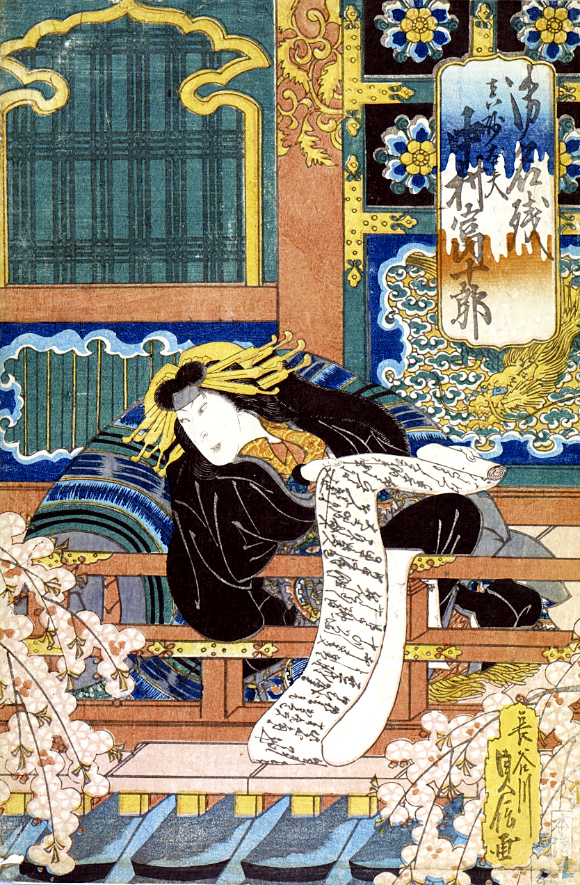| ONNA GOEMON |
| Play titles | Keisei Hama no Masago Keisei Masago no Shiranami |
| Author | Nishizawa Ippô |
| History |
Nishizawa Ippô's drama "Keisei Hama no Masago" was premiered in the 1st lunar month of 1839, in Ôsaka at the Kado no Shibai [casting]. This drama was very popular during the Edo period but went into oblivion during the Meiji era (only staged in Ôsaka koshibai on rare occasions). It was successfully revived at the National Theatre in April 1981 [casting] and March 1994. It was decided for these two revivals to use real names for the historical figures, like Toyotomi Hideyoshi or Akechi Mitsuhide instead of the usual disguised names Mashiba Hisayoshi or Takechi Mitsuhide. It was planned to stage only the "Nanzenji Sanmon" scene (the Sanmon gate at the Nanzenji Temple) in January 1998 at the Kabukiza, with Nakamura Utaemon VI and Onoe Kikugorô VII in the roles of the keisei Ishikawaya Masagoji and Hisayoshi. Unfortunately, Nakamura Utaemon VI was too frail to perform it and "Onna Goemon" was replaced by "Onna Date". The opportunity to stage this scene as an independent act arose again ten years after, in January 2008 at the Kabukiza, with Nakamura Jakuemon IV and Nakamura Kichiemon II in the roles of the keisei Ishikawaya Masagoji and Hisayoshi (the stage name was used instead of the real name). |
| Structure |
"Keisei Hama no Masago" is currently made up of 4 acts divided into 10 scenes. The opening act, "Nanzenji Sanmon" (the Sanmon gate at the Nanzenji Temple), is the spectacular opening act, which lasts less than 20 minutes. It is nicknamed "Onna Goemon", the Female Goemon, and is similar to the famous "Sanmon". |
| Key words |
Akechi Mitsuhide Ishikawa Goemon Jidaimono Keisei Kiseru Mashiba Hisaaki Mashiba Hisatsugu Mashiba Hisayoshi Nanzenji Taikôki Takechi Mitsuhide Toyotomi Hideyori Toyotomi Hideyoshi |
| Summary |
The play opens on the magnificent Nanzenji temple vermilion gate, located on the eastern hills of Kyôto and commonly called Sanmon. Seated on the balcony of this gate, a beautiful keisei enjoys the beauty of the surroundings while smoking with her kiseru. The keisei's name is Ishikawaya Masagoji but she is in reality the daughter of Akechi Mitsuhide, who was ruined and killed by the warlord Mashiba Hisayoshi. She was previously known as Princess Satsuki. Although she was able to retrieve the plover bird that her arch-enemy stole from her father, she wants to avenge the death of her father. She has asked Hisayoshi to come to the Nanzenji temple. In order to complicate matters, she has fallen in love with Mashiba Hisaaki, who is the son of the hated Hisayoshi. Masagoji is enjoying the view of the cherry blossoms blooming profusely as far as the eye can see. Suddenly, a wild goose comes flying by the gate and drops a letter before flying off in the Kyôto sky. Masagoji picks up the letter and, to her horror, she realizes that it is a love letter from a lady named Hayase to Hisaaki. Burning with jealousy, Masagoji inadvertently starts to clench the letter that she is holding in her hand. She is interrupted by a man's voice from below, which says: "Even if the sand from the beach ceases to exist..." Masagoji peers down to see her enemy Mashiba Hisayoshi, who is dressed like a pilgrim. Hisayoshi looks up at Masagoji and continues his speech: "...the seed of love will never disappear" Masagoji immediately throws down her beautiful and luxurious hairpin, which is caught by Hisayoshi with a spoon. This is the end of their very first encounter. This summary would have not been possible without the help of Sekidobashi Sakura! |
 |
|
The actor Nakamura Tomijűrô II playing the role of the keisei Ishikawaya Masagoji in the drama "Keisei Hama no Masago", which was staged in the 1st lunar month of 1839 in Ôsaka at the Kado no Shibai (print made by Hasegawa Sadanobu I) |
|
|
| Contact | Main | Top | Updates | Actors | Plays | Playwrights | Programs | Links | FAQ | Glossary | Chronology | Illustrations | Prints | Characters | Derivatives | Theaters | Coming soon | News |